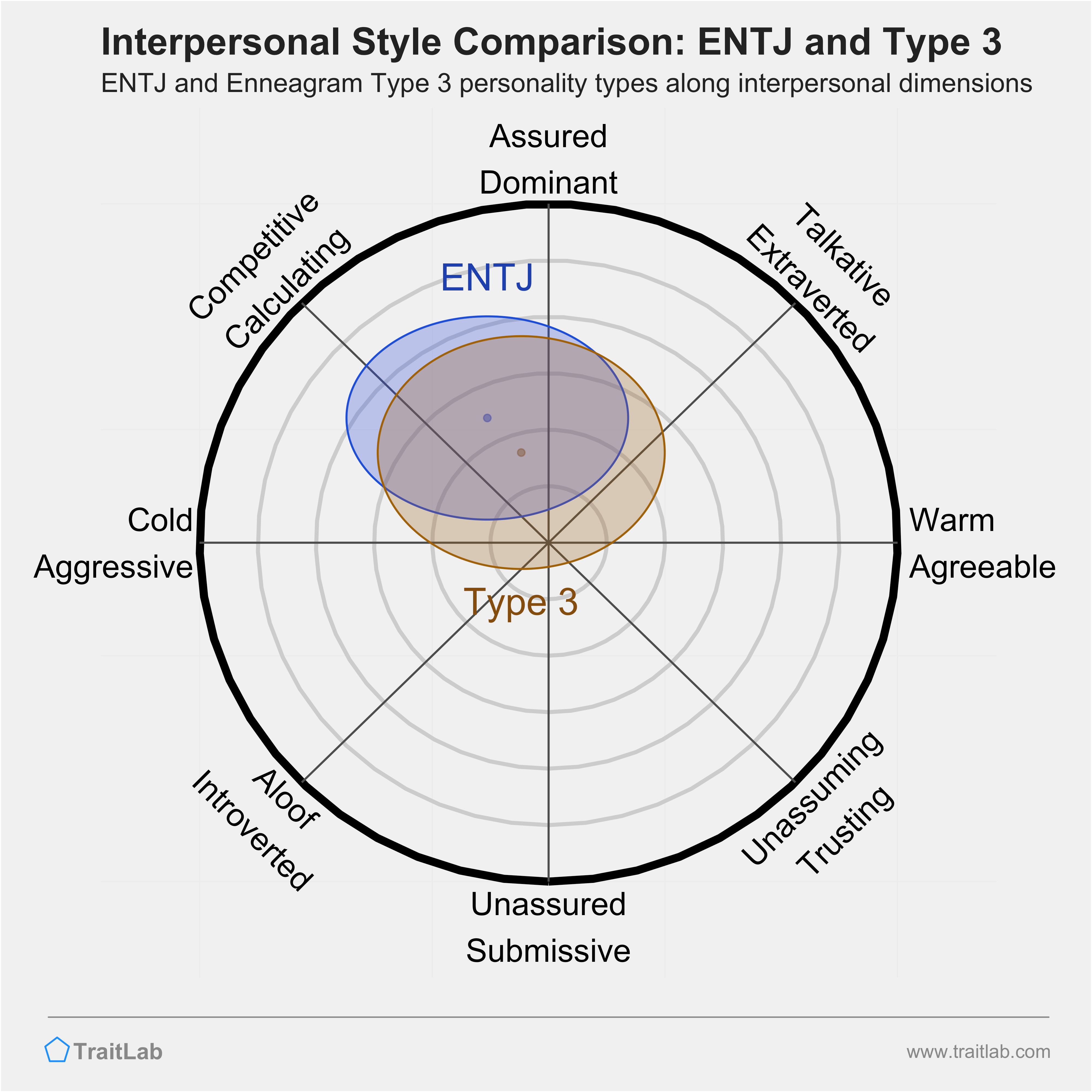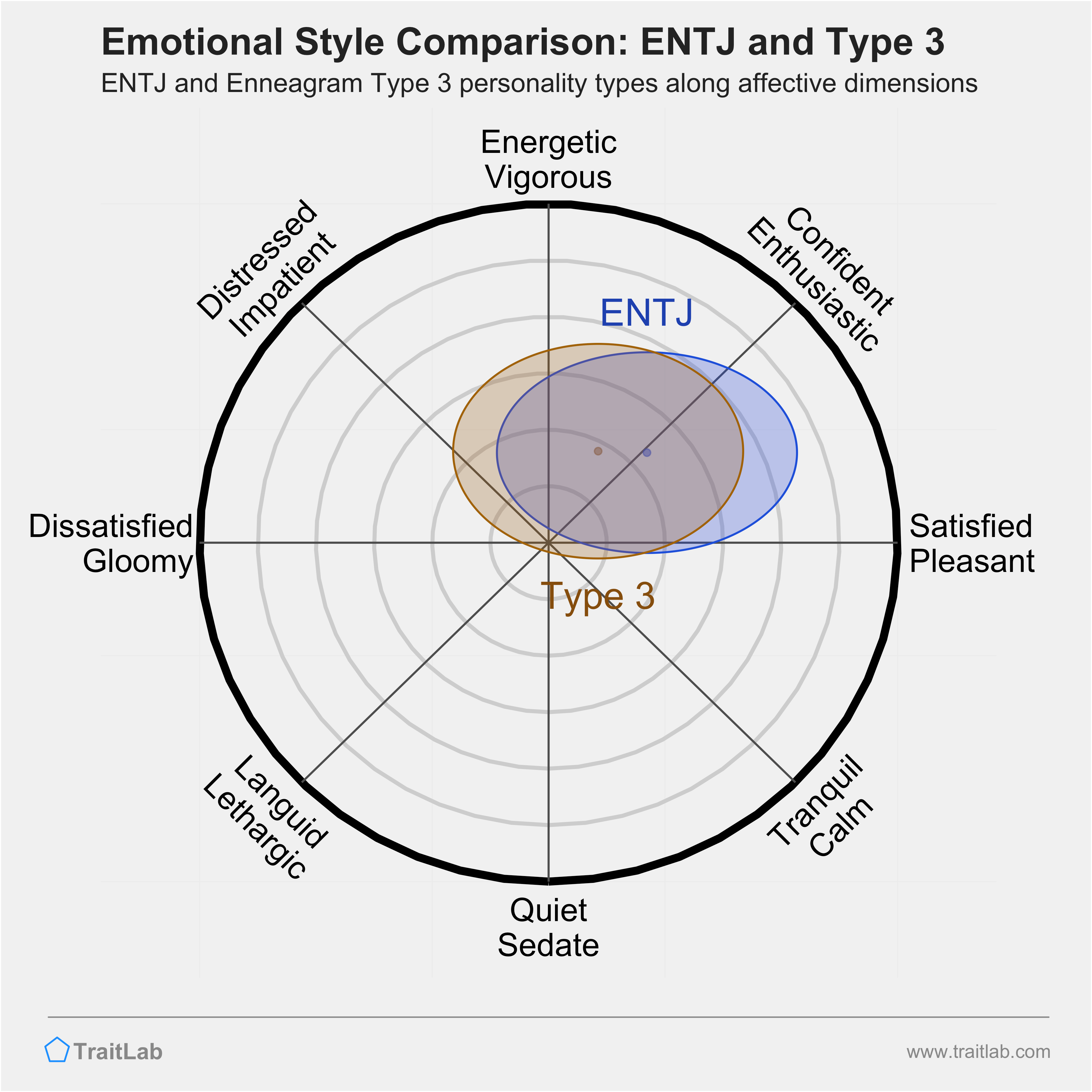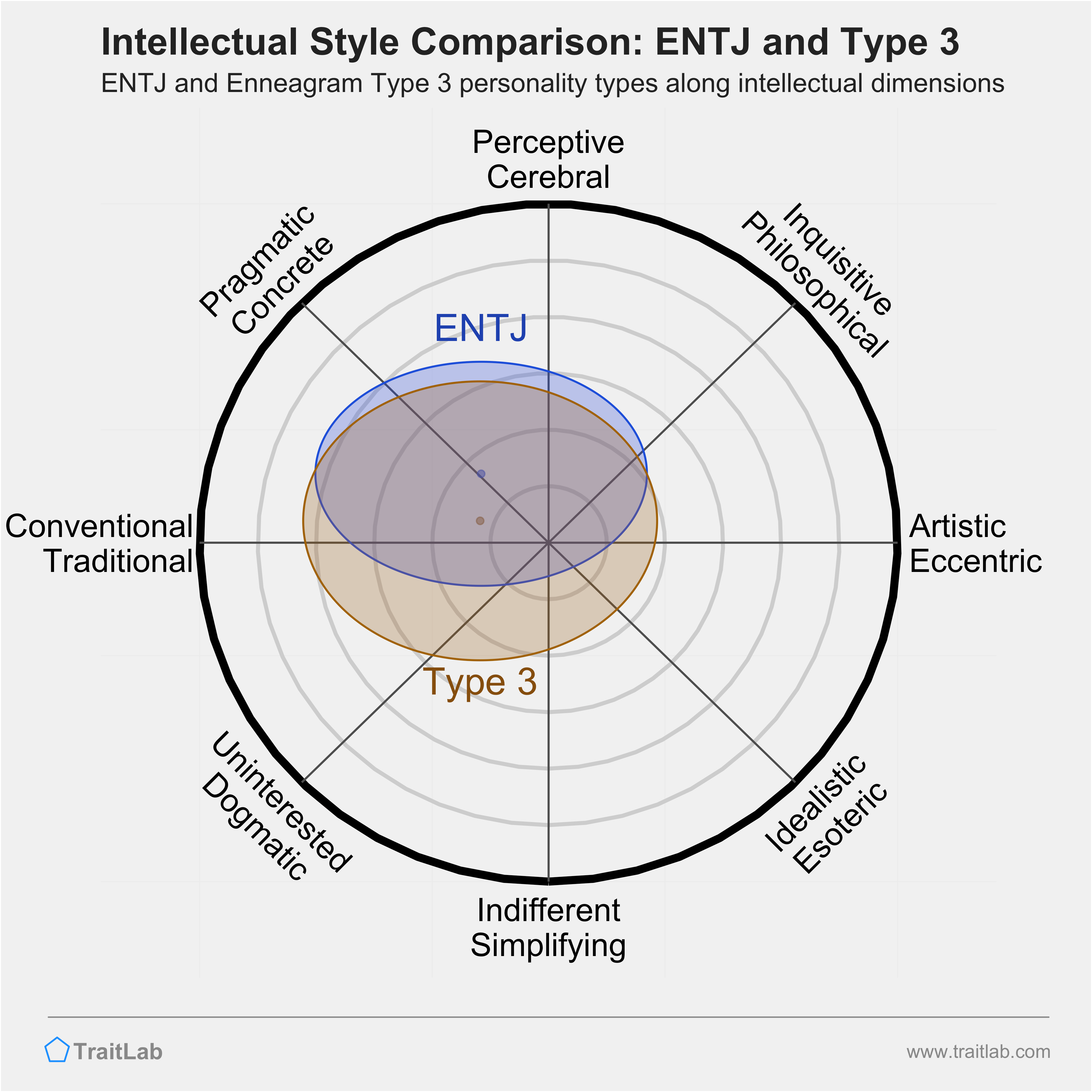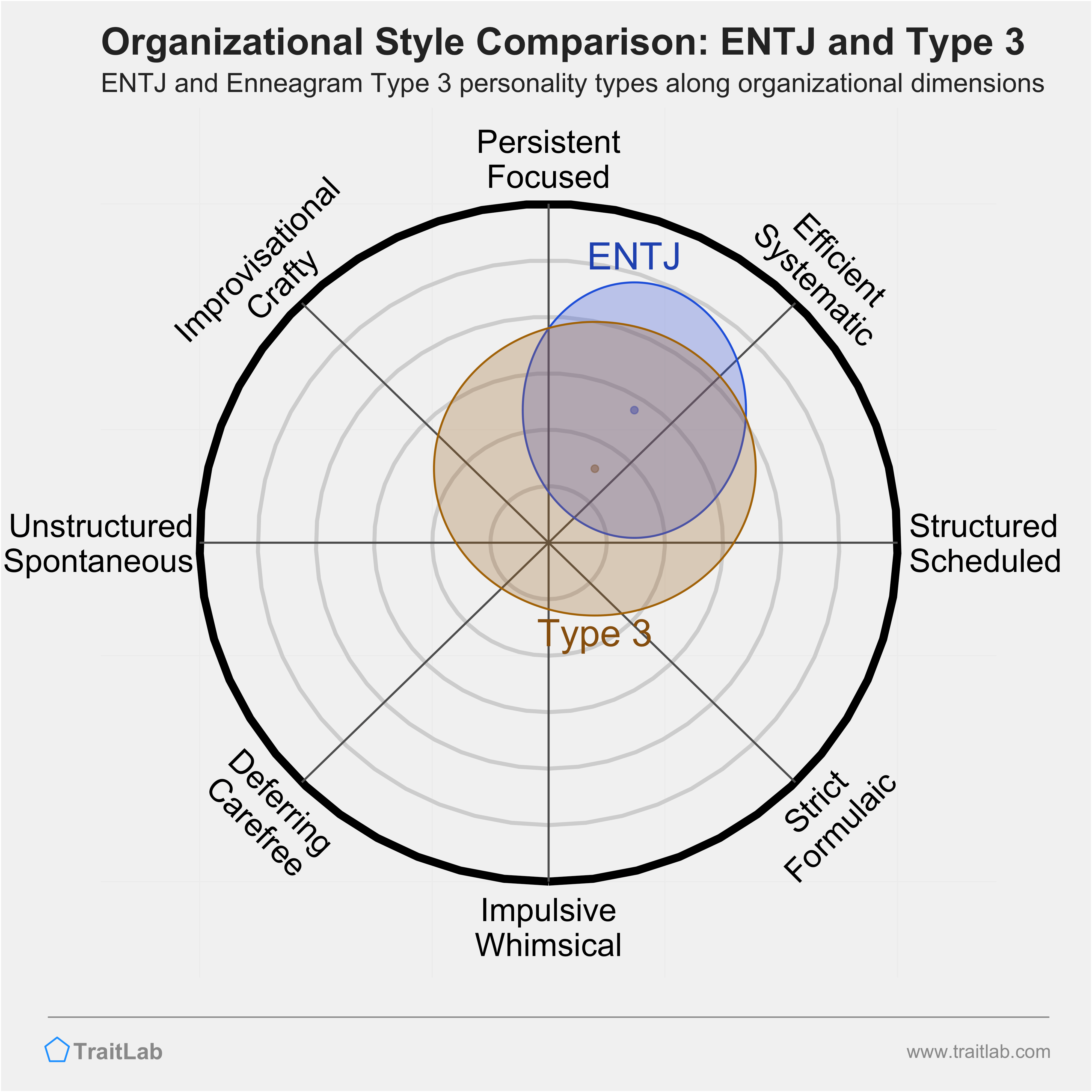How compatible are the ENTJ and Enneagram Type 3 patterns of communicating, feeling, and thinking?
Reading time: 5 minutes

Gregory Park, Ph.D.
Author
In this article, you’ll find comparisons of two personality types — ENTJs and the Enneagram Type 3s — across four important personality domains: Interpersonal/Communication Style, Emotional Style, Intellectual Style, and Organizational Style.
TraitLab collected data about personality traits from thousands of participants who identified as a particular type from the 16 Personality or Enneagram typology.
For each comparison area below, you’ll see show the average similarities and differences between ENTJs and Type 3s. While these comparisons are useful for understanding broad trends across these types, it’s important to remember that all personality types are oversimplifications. For an assessment of your unique personality, you’ll want to use an assessment that goes beyond single personality types.
Jump to any section with the links below.

Do you know your personality type?
Learn about your type and so much more with TraitLab's comprehensive personality assessment.
Your particular style of communicating and interacting with others can be described fairly well by two dimensions: assertiveness and warmth.
Assertiveness describes your tendency to assert yourself, lead, and influence others in social situations, while warmth describes your tendencies to empathize and put others’ needs ahead of your own.
People with the same personality type often share some similarities in assertiveness and warmth. In the graph below, you can see where most ENTJs and most Type 3s fall along both of these dimensions.
First, take a look at where people in each type, on average, fall in this interpersonal space.

ENTJs are assertive, competitive, and like a good challenge. At their best, they are bold and confident leaders who are willing to take unpopular action. ENTJs may be overly proud, boisterous, and willing to manipulate others to achieve their goals. At their worst, they can be narcissistic, overly focused on their own needs, and lack empathy for others.
Type 3s often manage, direct, and try to lead others. At their best, they provide guidance and leadership, and naturally command respect. Type 3s may be domineering, forceful, or overly direct. At their worst, they can be overbearing and micromanaging.
One aspect that ENTJs like you and many Type 3s have in common in your relative comfort around interpersonal conflict and disagreements. Both ENTJs and Type 3s are both likely to focus on their own point of view and goals, even if it leads to some interpersonal tension.
Likewise, you and most Type 3s both tend to be more assertive and dominant in social situations. You are both managing, directing, and leading others, and feel comfortable taking the lead. This may lead you to butt heads with some Type 3s, because at times, you can both be domineering or overly direct.
Another characteristic of your personality is your emotional style — your tendencies towards different kinds of moods. There are two dimensions that influence emotional style: arousal and valence.
Arousal describes your relative energy level across different situations. Those with high baseline levels of arousal tend to be generally more alert, active, and engaged, while those with a lower baseline are more reserved, subdued, and inhibited.
Valence describes whether these moods tend to be positive (pleasant) or negative (unpleasant). People with a more positively valenced style are more likely to experience emotions like joy, enthusiasm, satisfaction, and serenity. People with a more negatively valenced style are more likely to experience sadness, frustration, dissatisfaction, and anxiety.
The graph below shows where each type, on average, usually sits in this emotional space.

Most ENTJs and Type 3s overlap heavily in their emotional style.
ENTJs and Type 3s tend to be energetic and enthusiastic across most situations. They take on new challenges with excitement, confidence, and a sense of adventure. ENTJs and Type 3s are usually more optimistic than most people, and they generally feel like they can handle what life throws at them.
Like most ENTJs, you and many Type 3s share a relatively high energy level. You both prefer to be in motion, actively engaged in something interesting, rather than sitting back and observing. In the best case, the two of you feed off the other’s energy and excitement, and there’s rarely a quiet moment when you’re together.
Likewise, both ENTJs and Type 3s are generally more positive than negative. They are more likely to express enthusiasm, satisfaction, happiness, and other positive emotions across most situations. Like everyone else, they occasionally experience negative emotions like sadness, anxiety, and anger, but they soon return to their usual pleasant state. Together, ENTJs and Type 3s tend to share an optimistic outlook and a resilience to stress.
Your intellectual style describes how you receive, process, and pursue different kinds of information. Differences in intellectual style are captured well by two dimensions: ideas and aesthetics.
Ideas describes your appetite for new information and your interest in complex, challenging material. People high on the ideas dimension have an appreciation for complexity and technical details. People lower on ideas are less interested in learning for learning’s sake, and they prefer to simplify complex topics down to the essential details.
Aesthetics captures your relative interest and sensitivity to aesthetic information and its emotional impact. People higher on the aesthetics dimension usually have strong artistic interests and a deep appreciation for beauty in many forms. Those lower on aesthetics tend to value practical application over artistic merit and usually adhere to more conventional standards of beauty.
In the graph below, you’ll see where ENTJs and Type 3s, on average, fall in this intellectual space.

Most ENTJs and Type 3s overlap heavily in their intellectual style.
ENTJs and Type 3s are usually highly effective, efficient thinkers, capable of processing large amounts of complex information and distilling it down to its most useful elements. They are pragmatic and grounded and prefer to apply their knowledge to conventional, practical pursuits.
As a ENTJ, you and many Type 3s share a love of learning new, challenging ideas. You both appreciate complexity and nuance, and the two of you can spend hours discussing and debating a wide range of topics. When you are together, you often elevate the conversation to a more theoretical, philosophical level.
Likewise, ENTJs and Type 3s share an appreciation for practical, tangible accomplishments over artistic expression. ENTJs and Type 3s are both likely to embrace conventional ways of thinking, and both types are more skeptical of eccentric or unusual approaches to solving problems.
Your organizational style describes your habits around organization and planning. Your organizational style influences how you structure your time and physical space. Differences in organizational style fall along two dimensions: industriousness and orderliness.
Industriousness describes your persistence, need for achievement, and intensity of focus. People higher on industriousness usually organize their behavior around a few important long-term goals. People lower on industriousness are usually more focused on the present and will more easily change their focus when new opportunities appear.
Orderliness describes your need for regularity, order, and structure in your environment. People higher on orderliness prefer tidy, organized physical spaces, detailed schedules, and reliable routines. People lower on orderliness can tolerate more disorganization and prefer a more spontaneous, unstructured approach.
The graph below shows the average position of ENTJs and Type 3s along these dimensions of organizational style.

Most ENTJs and Type 3s share a similar organizational style.
ENTJs and Type 3s are usually systematic and highly organized. They like setting big, long-term goals and then creating detailed plans to accomplish them. ENTJs and Type 3s are generally good at ignoring distractions and making steady progress through consistent routines and habits.
As a ENTJ, you and most Type 3s share a natural drive to achieve and perform at a high level. Both of you enjoy setting goals and pushing yourselves to accomplish them, and you likely share an interest in self-improvement and productivity strategies. As a result, you and your Type 3 counterpart can fuel each other’s ambition and keep each other accountable as you work towards your long-term goals. However, between the two of you, nobody usually reminds you to slow down and enjoy the present.
Similarly, ENTJs and Type 3s tend to be neat, tidy, and organized. You both rely on high amounts of structure and routine and compared to most people, you have lower tolerances for messiness and disorder. With a few exceptions, both of you stick closely to most social conventions and feel uncomfortable straying from them.
Most people have complex personalities, and they don’t fit perfectly into a single personality type.
With TraitLab’s comprehensive analyses of your traits, strengths, and interests, you can see how your personality compares to every type from the Enneagram and 16 Personality typologies. Start building your personality profile by creating a free account today.
For comparisons between ENTJs and other Enneagram types, visit any of the type pairings below:
For comparisons between Type 3s and other types from the 16 Personality typology, visit any of the pairings below: